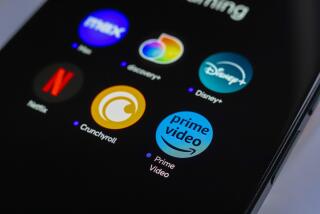Santa Ana Law Seeks to Curb Proliferation of Pay Phones
For generations, the pay phone symbolized comfort and convenience for those needing to stay connected.
But as the number of public phones has skyrocketed in the last decade, some communities are beginning to see them more as graffiti-covered, unreliable eyesores than as sights for sore eyes.
Santa Ana this month joined an increasing number of cities across the nation to enact strict ordinances aimed at removing thousands of phones that crowd their streets--and invade some residential areas as well.
Even as cellular telephones become a staple of cars and purses, pay phones continue to proliferate thanks to federal deregulation--with 65,000 new ones popping up across California in eight years.
Santa Ana’s measure is considered the most restrictive in the state and has angered pay phone owners who say they will be forced to remove the majority of the city’s 1,500 outdoor phones.
But the new rules--and others like them elsewhere--are hailed by residents who say the phones blight their communities.
“I wish they were all yanked out,” Debbie McEwen said, pointing out that the phone booth near her Santa Ana home is plagued by graffiti, cigarette butts and loiterers. “They’re magnets. People hang out all day and all night.”
Critics complain that many of the newer pay phones are poorly maintained and that the enclosures are used as unsightly billboards to sell products.
Preservationists in New York are fighting plans to add nearly 20,000 public phones across the city, fearful that the booths will block views of historic landmarks and sully Manhattan’s street-scape.
Many Cities Have OKd Law
Dozens of cities large and small have passed ordinances in recent years. Huntington Park bans pay phones on private property in its business district, a law that is being challenged by the telephone industry. In downtown Perth Amboy, N.J., the city prohibits booths within 600 feet of each other. Chicago officials have removed thousands of pay phones outside stores.
Although some older ordinances aim to deter drug dealing and prostitution, communities are increasingly focusing on aesthetics.
Pay phone owners say Santa Ana’s landmark law unfairly infringes on their rights.
“It’s not just my pay phones in Santa Ana I’m worried about. It’s my 930 phones I have in Southern California,” said owner Ken Scott, president of San Diego Pay Phone Owners Assn. “If this takes off in other cities, it’s going to be a mess out there, and it’s a mess that doesn’t need to happen.”
The prospect of removing booths has also sparked safety concerns among some community activists, who point out that one-third of all 911 calls in Santa Ana come from pay phones.
Jack Elwir, owner of H&H; Liquor Store on Civic Center Drive, said the three phones outside his businesses are used regularly by people making calls to family in Mexico. “A lot of customers don’t have phones--or even cars,” he said.
Until recently, Claudia Vasquez said the phone outside her home on McClay Street was her main link to friends and family because she did not have the identification required to obtain her own phone.
“They can’t remove the phones,” said Vasquez, who recently had a line installed in her home. “People use them all the time.”
The pay phone explosion is the result of federal deregulation begun in the 1980s that allowed independent phone operators to compete with large companies like GTE and Pacific Bell.
Private operators have aggressively targeted densely populated, lower-income areas where residents are most likely to need pay phones and least likely to own cellular or even home phones.
Virtually any business that attracts foot traffic--gas stations, mini-marts, doughnut shops--is prime terrain, and the business owners are usually happy to cooperate because they share in the profits. Many strip malls in Southern California now boast two or three booths where a decade ago only one stood.
In Santa Ana, the growth has been so rapid that officials aren’t sure how many phones have been installed because many new ones were erected without the required city permits.
Some stand so close to streets that the roar of traffic makes it difficult to hold a conversation, they said. Others are clustered in dimly lighted parking lots, sprouting overhead wires that hang precariously over parked cars.
At one corner in Santa Ana, a pay phone was placed inside a fenced-off property, with a small portion of the fence sawed off so that customers could reach the receiver and dial.
“You drive down the street, and it seems a dozen of them have sprouted overnight,” said City Councilwoman Lisa Bist. “It’s out of control.”
Rapid Growth Across State
Statewide, the number of pay phones has increased by nearly 65,000 to about 265,000 since 1990, according to Public Utilities Commission figures. Practically all the new phones were installed by independent companies.
Santa Ana’s ordinance does not target specific phones for removal but rather establishes strict rules that owners said would make it too costly to change and operate the phones.
Among the measures the owners consider overly restrictive is one that limits the amount of exposed conduit connecting phone lines to booths. This rule would force many phones to be moved or removed, owners said.
Another controversial rule prohibits the use of exposed wires connecting a pay phone to overhead lines, which is considered by owners as an inexpensive way to install booths.
Owners vow to fight the ordinance in court, saying that it punishes the entire industry for the sins of a few irresponsible operators.
Tom Weber, a vice president at Pacific Bell, the largest owner of pay phones in Santa Ana, said about 210 of the company’s 300 phones in the city do not comply with the new measures.
“There is no doubt in my mind as a result of this ordinance there will be a reduction in pay phones,” he said.
City officials insist that pay phone owners are exaggerating the law’s impact, noting that they will have three years to comply with the new measures. Santa Ana residents, they say, will still have easy access to pay phones.
Huntington Park in 1995 approved a law requiring the removal of more than 70 pay phones along its Pacific Boulevard shopping district to cut down on crime and fraud. Authorities said the phones were being used by people with stolen calling cards who offered cut-rate long-distance calls to passersby.
The ban was suspended after pay phone owners filed a lawsuit, and no phones have been removed since then. City officials now hope to reach a compromise with owners.
Activists in other cities such as New York expressed interest in following Santa Ana’s lead.
Vanessa Gruen, the director of special projects at the Municipal Art Society of New York City, said Santa Ana’s ordinance sounds like a great idea and hopes New York will adopt similar measures to combat the “free-for-all” proliferation of pay phones.
The small Florida town of Lake Park has attempted to ban all outdoor pay phones in the city limits, claiming that they breed crime. But pay phone owners have challenged the law in court, arguing that it violates the rights of people who can’t afford phones.
Lance Norris, the president of the Florida Public Telecommunications Assn., said: “In South Florida it seems if you don’t have a cell phone, you’re considered a second-class citizen.”
More to Read
Sign up for Essential California
The most important California stories and recommendations in your inbox every morning.
You may occasionally receive promotional content from the Los Angeles Times.











